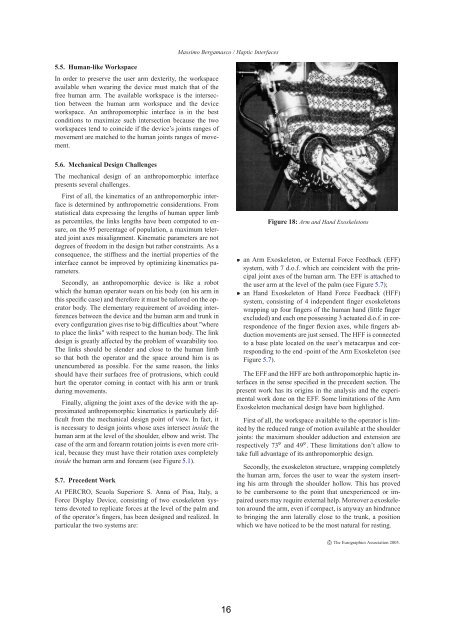full Paper - Nguyen Dang Binh
full Paper - Nguyen Dang Binh
full Paper - Nguyen Dang Binh
Create successful ePaper yourself
Turn your PDF publications into a flip-book with our unique Google optimized e-Paper software.
5.5. Human-like Workspace<br />
In order to preserve the user arm dexterity, the workspace<br />
available when wearing the device must match that of the<br />
free human arm. The available workspace is the intersection<br />
between the human arm workspace and the device<br />
workspace. An anthropomorphic interface is in the best<br />
conditions to maximize such intersection because the two<br />
workspaces tend to coincide if the device’s joints ranges of<br />
movement are matched to the human joints ranges of movement.<br />
5.6. Mechanical Design Challenges<br />
The mechanical design of an anthropomorphic interface<br />
presents several challenges.<br />
First of all, the kinematics of an anthropomorphic interface<br />
is determined by anthropometric considerations. From<br />
statistical data expressing the lengths of human upper limb<br />
as percentiles, the links lengths have been computed to ensure,<br />
on the 95 percentage of population, a maximum telerated<br />
joint axes misalignment. Kinematic parameters are not<br />
degrees of freedom in the design but rather constraints. As a<br />
consequence, the stiffness and the inertial properties of the<br />
interface cannot be improved by optimizing kinematics parameters.<br />
Secondly, an anthropomorphic device is like a robot<br />
which the human operator wears on his body (on his arm in<br />
this specific case) and therefore it must be tailored on the operator<br />
body. The elementary requirement of avoiding interferences<br />
between the device and the human arm and trunk in<br />
every configuration gives rise to big difficulties about "where<br />
to place the links" with respect to the human body. The link<br />
design is greatly affected by the problem of wearability too.<br />
The links should be slender and close to the human limb<br />
so that both the operator and the space around him is as<br />
unencumbered as possible. For the same reason, the links<br />
should have their surfaces free of protrusions, which could<br />
hurt the operator coming in contact with his arm or trunk<br />
during movements.<br />
Finally, aligning the joint axes of the device with the approximated<br />
anthropomorphic kinematics is particularly difficult<br />
from the mechanical design point of view. In fact, it<br />
is necessary to design joints whose axes intersect inside the<br />
human arm at the level of the shoulder, elbow and wrist. The<br />
case of the arm and forearm rotation joints is even more critical,<br />
because they must have their rotation axes completely<br />
inside the human arm and forearm (see Figure 5.1).<br />
5.7. Precedent Work<br />
At PERCRO, Scuola Superiore S. Anna of Pisa, Italy, a<br />
Force Display Device, consisting of two exoskeleton systems<br />
devoted to replicate forces at the level of the palm and<br />
of the operator’s fingers, has been designed and realized. In<br />
particular the two systems are:<br />
Massimo Bergamasco / Haptic Interfaces<br />
16<br />
Figure 18: Arm and Hand Exoskeletons<br />
¯ an Arm Exoskeleton, or External Force Feedback (EFF)<br />
system, with 7 d.o.f. which are coincident with the principal<br />
joint axes of the human arm. The EFF is attached to<br />
the user arm at the level of the palm (see Figure 5.7);<br />
¯ an Hand Exoskeleton of Hand Force Feedback (HFF)<br />
system, consisting of 4 independent finger exoskeletons<br />
wrapping up four fingers of the human hand (little finger<br />
excluded) and each one possessing 3 actuated d.o.f. in correspondence<br />
of the finger flexion axes, while fingers abduction<br />
movements are just sensed. The HFF is connected<br />
to a base plate located on the user’s metacarpus and corresponding<br />
to the end -point of the Arm Exoskeleton (see<br />
Figure 5.7).<br />
The EFF and the HFF are both anthropomorphic haptic interfaces<br />
in the sense specified in the precedent section. The<br />
present work has its origins in the analysis and the experimental<br />
work done on the EFF. Some limitations of the Arm<br />
Exoskeleton mechanical design have been highlighed.<br />
First of all, the workspace available to the operator is limited<br />
by the reduced range of motion available at the shoulder<br />
joints: the maximum shoulder adduction and extension are<br />
respectively 73 Æ and 49 Æ . These limitations don’t allow to<br />
take <strong>full</strong> advantage of its anthropomorphic design.<br />
Secondly, the exoskeleton structure, wrapping completely<br />
the human arm, forces the user to wear the system inserting<br />
his arm through the shoulder hollow. This has proved<br />
to be cumbersome to the point that unexperienced or impaired<br />
users may require external help. Moreover a exoskeleton<br />
around the arm, even if compact, is anyway an hindrance<br />
to bringing the arm laterally close to the trunk, a position<br />
which we have noticed to be the most natural for resting.<br />
c The Eurographics Association 2005.
















